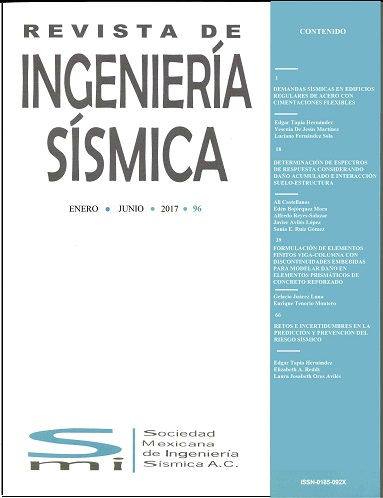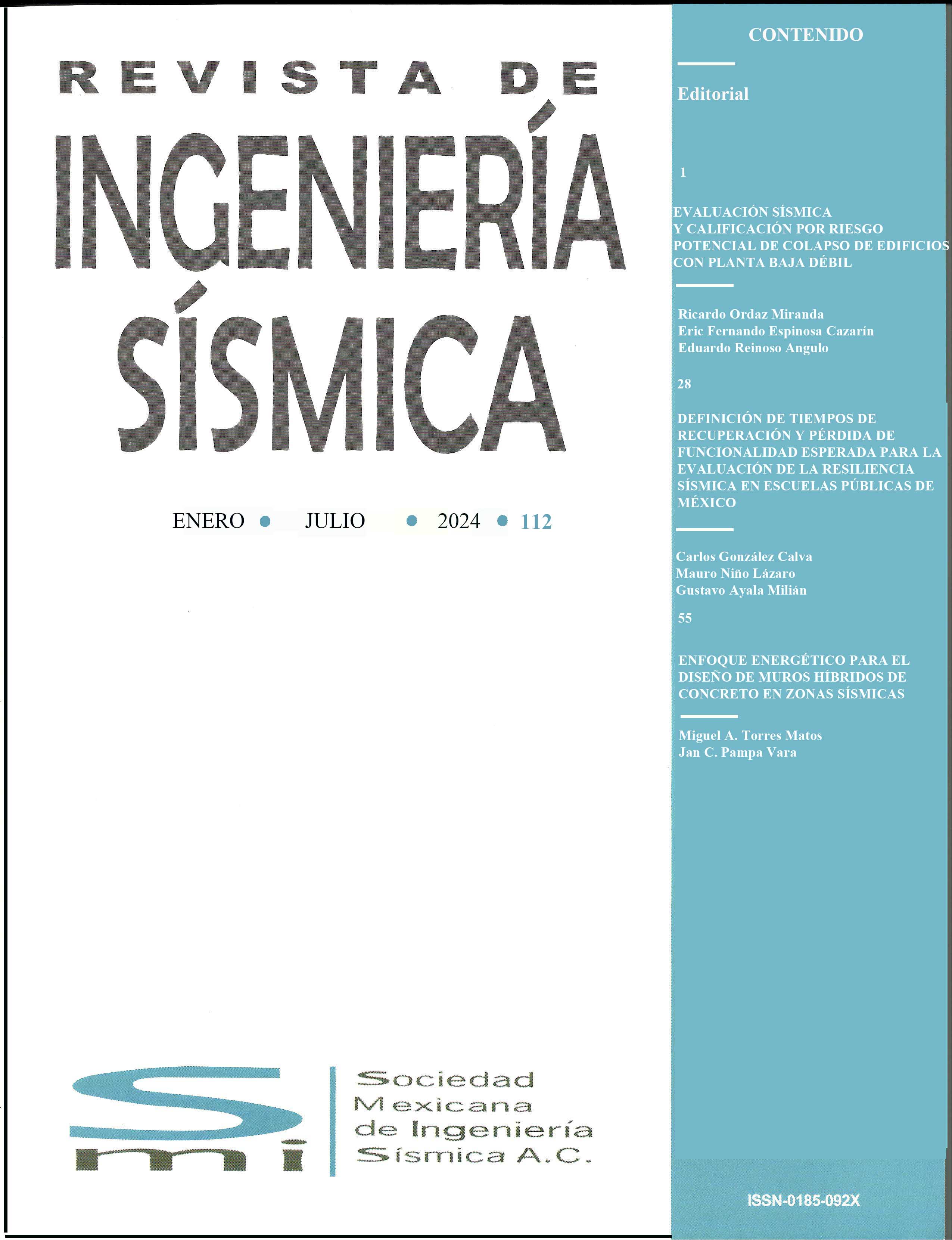RETOS E INCERTIDUMBRES EN LA PREDICCIÓN Y PREVENCIÓN DEL RIESGO SÍSMICO
DOI:
https://doi.org/10.18867/ris.96.186Resumen
El artículo discute desde un punto multidisciplinario el estado actual de las predicciones sísmicas con sustento científico basados en precursores físicos, métodos estadísticos y los requisitos mínimos que deben considerarse para identificar métodos razonables; especialmente, los encaminados a la prevención sísmica. Sobre la cultura de la prevención se discuten cambios históricos relacionados con la población vulnerable y marginal, su progreso en relación al desarrollo científico, la evidencia antropológica sobre la eficacia de las predicciones y su influencia en la cultura de la prevención para enfrentar riesgos comunes, el sistema de alerta temprana de sismos y la influencia de las predicciones en las expectativas y decisiones de inversión.
Descargas
Citas
Alexander D.E. (2014), “Communicating earthquake risk to the public: the trial of the ‘L’Aquila Seven” Natural Hazards Vol. 72. pp.1159–1173. DOI:10.1007/s11069-014-1062-2
Arjonilla E. (1988), “Evaluación de la alerta sísmica para la Ciudad de México desde una perspectiva sociológica. Resultados en poblaciones escolares con y sin alerta” Internacional IDNDR - Conference on Early Warning Systems for Reduction of Natural Disasters. Chile. Abril.
Bakun W.H., Breckenridge K.S., Bredehoeft J., Burford R.O., Ellsworth W.K., Johnston M.J.S., Jones L., Lindh A.G., Mortensen C., Mueller R.J., Poley C.M., Roeloffs E., Schulz S., Segall P. y Thatcher W. (1987), "Parkfield California, Earthquake Prediction Scenarios and Response Plans", Report 87-192 Geological Survey. Department of the Interior. Estados Unidos. Mayo.
Barrios, R.E. (2014), “Here, I’m not at ease: Anthropological perspectives on community resilience.” Disasters, Vol. 38. Pp. 329–350. DOI:10.1111/disa.12044
Carranza J.A. (1993), “La Prevención y la cultura sísmica” Memorias, 1er. Congreso Nacional de Universidades en Protección Civil. UNAM, diciembre. México
CIRES (2015), Sitio de internet del Centro de Instrumentación y Registro Sísmico, A.C. www.cires.mx. México. Fecha de consulta marzo 2015.
CNR (1986), "Bases para el establecimiento de una sistema nacional de protección civil. Protección Civil: México", Comisión Nacional de Reconstrucción. Distrito Federal.
Curiel G. (2010), “Teoría de las fuerzas gravitacionales”, Memorias, XVIII Congreso Nacional de Ingeniería Sísmica, Aguascalientes, México.
Dragert H., Wang K.y James T.S. (2001), "A Silent Slip Event on the Deeper Cascadia Subduction Interface", Science Journal, Vol. 292. pp. 1525-1528. DOI:10.1126/science.1060152
Dutta H.N., Dabas R.S., Rupesh M.D., Kavita S. y Bhupender S. (2007), “Ionospheric perturbations over Delhi caused by the 26 December 2004 Sumatra earthquake”, International Journal of Remote Sensing, Vol. 28, No. 13-14, pp. 3141-3151. DOI:10.1080/01431160601099590
Dynes R.R., Quarentelli E.L. y Wenger D., (1990), "Individual and Organizational Response to the 1985 Earthquake in Mexico City", Technical Report. Disaster Research Center, University of Delaware.
Echevarria J.A., Norton K.A. y Norton R.D. (1986). "The socioeconomic consequences of earthquake prediction". Journal of Earthquake Prediction Research, Vol. 4. Pp 175-193. ISSN 1002-1604
Farley J.E., Barlow H.D., Finkelstein M.S. y Riley L. (1993), "Earthquake hysteria, before and after: A survey and follow-up on public response to the browning forecast", International Journal of Mass Emergencies and Disasters Vol. 11 Issue 3. Pp. 305- 321. ISSN 0280-7270.
FEMA-474 (2005), “Promoting Seismic Safety: Guidance for Advocates”. Federal Emergency Management Agency. Washington. Septiembre.
Galbraith, K. (1991), “Breve historia de la euforia financiera”, Editorial Ariel, tercera edición, Barcelona, España.
García V., Hernández R., Molina I., Pérez A., Rojas J.M. y Sacristán C.T. (1988), “Cronología de los sismos en la cuenca del valle de México”. Estudios Sobre Sismicidad en el Valle de México. Departamento Del Distrito Federal Secretaria General de Obras. México.
García V. y Suárez G. (1996), "Los Sismos en la Historia de México". Vol. 1.Universidad Nacional Autónoma de México Press. México.
García V. y Rojas T. (1994), “Los sismos como fenómeno social: una visión histórica”, Macrosismos: Aspectos Físicos, Sociales, Económicos y Políticos, Ed. Centro de Investigaciones y Estudios Superiores en Antropología Social. México.
Gratton V.G., Their H.D., Arjonilla E. y Melgar R. (1987), “The recovery of schools from earthquake effects: Lessons from Mexico City”, Disasters. Vol. 11, Issue 4. Pp. 310-316. DOI:10.1111/j.1467-7717.1987.tb00654.x
Guo, G. y Bin W. (2008). “Cloud anomaly before Iran earthquake”, International Journal of Remote Sensing, Vol. 29, No. 7. Pp. 1921-1928. DOI:10.1080/01431160701373762
Haas J.E. y Mileti D.S. (1976), "Social Effects of Earthquake Prediction", Ed. Institute of Behavioral Science, University of Colorado.
Igarashi G. y Wakita H. (1995), “Geochemical and Hydrological Observations for Earthquake Prediction in Japan”, Journal of Physics of the Earth, Vol. 43, No. 5, pp. 585-598. DOI:10.4294/jpe1952.43.585
Igarashi G, Saeki S., Takahata N., Sumikawa K., Tasaka S., Sasaki Y., Takahashi M. y Sano Y. (1995), “Ground-water Radon Anomaly Before the Kobe Earthquake in Japan”, Science Journal, Vol. 269, No. 5220, pp. 60-61. DOI:10.1126/science.269.5220.60
Jordan T., Chen Y., Gasparini P., Madariaga R., Main I., Marzocchi W., Papadopoulos G., Sobolev G., Yamaoka K. y Zschau J., (2011) “Operational Earthquake Forecasting. State of Knowledge and Guidelines for Utilization”, International Commission on Earthquake Forecasting for Civil Protection, Annals of Geophosics, Vol. 54, No. 4, mayo. DOI:10.4401/ag-5350
Karababa F.S. y Guthrie P.M. (2007), “Vulnerability reduction through local seismic culture”. Technology and Society Magazine, IEEE. Vol. 26. Pp 30–41. DOI:10.1109/ISTAS.2006.4375887
Keynes, J.M. (1936), “Teoría General de la ocupación, el interés y el dinero”, Fondo de Cultura Económica, cuarta edición.
Lees S.H. (1980), “The Hazards approach to development research: recommendations for Latin American drylands”, Human Organization. Vol. 69. Pp 372–76. DOI:10.17730/humo.39.4.j221026444h54226
Lees S.H. y Bates D.G. (1990), “The ecology of cumulative change”. The Ecosystem Approach in Anthropology, Ed. EF Moran, 1:247–78. Ann Arbor: University of Michigan Press.
Liebow E.B. y Wolfe A.K., (1993), “Communities at risk: communication and choice of environmental hazards” Environmental Health. Vol. 15 pp. 237–39. DOI:10.1186/1476-069X-9-67
Macías, J. M. (1999), "Desastres y Protección Civil: Problemas Sociales, Políticos y Organizacionales". Ed. CIESAS. México.
Mankiw, G. (2007), “Macroeconomía”, Antoni Bosch Editor, Cuarta edición, España.
Mileti, D.S. y Fitzpatrick C. (1992), "The causal sequence of risk communication in the Parkfield Earthquake Prediction Experiment", Risk Analysis, Vol. 12 Issue 3. Pp. 393-400. DOI:10.1111/j.1539-6924.1992.tb00691.x
Mileti D.S. y Fitzpatrick C. (1993), "The Great Earthquake Experiment: Risk Communication and Public Action", Ed. Westview Press. ISBN-13 978-0813383699.
Mileti D.S., Cress D.M. y Darlington J.D., (2002), “Earthquake culture and corporate action”, Sociological Forum, Vol. 17. Pp. 161–180. DOI: 10.1023/A:1014549708645
Nagamine K. y Sugisaki R. (1991), “Co-seismic changes of subsurface gas compositions disclosed by an improved seismic-geochemical system”, Geophysical Research Letters, Vol. 18, Issue 12, pp. 2221-2224. DOI:10.1029/91GL02710
O’Keefe P., Westgate K. y Wisner B. (1976), “Taking the Naturalness Out of Natural Disasters.” Nature. Vol 260. DOI:10.1038/260566a0
Oliver-Smith A. (1986). "Natural Disasters and Culture Responses. Studies in Third World Societies", ERIC Institute of Education Sciences. Williamsburg, VA: Coll. William & Mary.
Oliver-Smith A. (1994) “Peru’s five hundred year earthquake: vulnerability in historical context” Disasters, Development, and Environment, Ed. A Varley, pp. 3–48. London: Wiley. ISBN-10 041591986x.
Oliver-Smith A. (1996), “Anthropological Research on Hazards and Disasters” Annual Review of Anthropology. Vol. 25. DOI:10.1146/annurev.anthro.25.1.303
Olson R.S., Podesta B. y Nigg J.M., (1989), "The Politics of Earthquake Prediction", Ed. Princeton University Press. Princeton, N.J. ISBN: 9780691608020.
Omori Y., Yasuoka Y., Nagahama H., Kawada Y., Ishikawa T., Tokonami S. y Shinogi M. (2007), “Anomalous radon emanation linked to pre-seismic electromagnetic phenomena”, Natural Hazards Earth System Sciences, Vol. 7, pp. 629-635. https://hal.archives-ouvertes.fr/hal-00299460.
Peña P. (2003), “Cambios de radón en suelo y elementos químicos y trazas en agua subterránea asociados a actividad sísmica”, Tesis doctoral, Universidad Autónoma Metropolitana, Abril.
Perrow C.B. (2008), “Complexity, Catastrophe, and Modularity”. Sociological Inquiry. Vol. 78 Issue 2. pp 162–173. DOI:10.1111/j.1475-682X.2008.00231.x
Richon P., Sabroux J., Punongbayan R. (2003), “Radon anomaly in the soil of Taal Volcano, the Philippines: A likely precursor of the M 7.1 Mindoro earthquake (1994)”. Geophysical Research Letters. Vol. 30 (9), pp. 1481. DOI:10.1029/2003GL016902
Richon P., Klinger Y., Tapponnier P., Chen-Xia L., Vann Der Woerd J. y Perrier F. (2010), “Measuring radon flux across active faults: relevance of excavating and possibility of satellite discharges”, Radiation Measurements, Elsevier, No. 45, pp. 211-218. DOI:10.1016/j.radmeas.2010.01.019
Saegusa A. (1999), "China clamps down on inaccurate warnings", Nature. International weekly journal of science, No. 397, 284. Enero. DOI: 10.1038/16760
Segovia N., Mena M., Peña P., Tamez E., Seidel J.K., Monnin M. y Valdés C. (1999), “Soil radón time series: surveys in seismic and volcanic areas”, Radiation Measures. Vol. 31. Issues 1-6. Pp. 307-312. Junio. DOI:10.1016/S1350-4487(99)00142-0
Singh S. y Ordáz M. (1994), "Sismicidad y movimientos Fuertes en México: Una visión actual", Cuaderno de investigación 18. Centro Nacional de Desastres, Cenapred. México.
SSN (2015), Sitio web del Servicio Sismológico Nacional, México (www.ssn.unam.mx). Instituto de Geofísica, Universidad Nacional Autónoma de México.
Suárez G. y García-Acosta V., (2014), "The seismic alert system in Mexico City: an example of a successful Early Warning System (EWS)", UNISDR Scientific and Technical Advisory Group Case Studies.
Süer S., Gülec N., Mutly H., Hilton D.R., Cifter C. y Sayin M. (2008), “Geochemical Monitoring of Geothermal Waters (2002-2004) along the North Anatolian Fault Zone, Turkey: Spatial and Temporal Variations and Relationship to Seismic Activity”, Pure and Applied Geophysics. Vol. 165, pp. 17-43. DOI:10.1007/s00024-007-0294-4
Tierney K. (2003), “Disaster Beliefs and Institutional Interests: Recycling Disaster Myths in the Aftermath of 9/11.” Terrorism and Disaster: New Threats, New Ideas, Vol. 11, Research in Social Problems and Public Policy. Emerald Group Publishing pp. 33–51. ISBN: 978-0-76231-043-2
Torry W.I. (1978), “Natural disasters, social structure and change in traditional societies.” Journal of Asian and African Studies. Vol 13. 167–183. DOI:10.1163/15685217-90007141
Toutain J.P. y Baubron J.C. (1999), “Gas geochemistry and seismotectonics: a review”, Tectonophysics, Elsevier. Vol. 304, No. 1. Issues 1-2. Pp. 1-27. DOI:10.1016/S0040-1951(98)00295-9
Turton D. (1977), “Response to drought: the Mursi of southwestern Ethiopia.” Disasters Vol. 1:275–87 DOI:10.1111/j.1467-7717.1977.tb00047.x
UNISDR (2005), “Hyogo Framework for Action 2005-2015: Building the Resilience of Nations and Communities to Disasters”, Organización de Naciones Unidas (ONU), Kobe, Hyogo, Japón. Enero.
UNISDR (2015), “Sendai Framework for Disaster Risk Reduction 2015-2030”, Organización de Naciones Unidas (ONU), Sendai, Japón. Marzo.
USGS (2015), "Historic World Earthquakes", Sitio web del Earthquake Hazard Program, United States Geological Survey, Department of the Interior. Abril. (http//earthquake.usgs.gov/earthquakes/world/historical.php).
USGS (2015a), "Earthquake Facts and Earthquake Fantasy", Sitio web del Earthquake Hazard Program, United States Geological Survey, Department of the Interior. Abril. (http://earthquake.usgs.gov/learn/topics/megaqk_facts_fantasy.php).
Weisbecker L.W., Stoneman W.C. y Ackerman S.E. (1977), "Earthquake Prediction, Uncertainty, and Policies for the Future: A technology assessment of earthquake prediction". Ed. Stanford Research Institute. Menlo Park, Calif.
Wolfe A.K. (1988) “Risk communication: Who’s educating whom?” Pract. Anthropol. Vol. 10, pp. 13-14. DOI:10.17730/praa.10.3-4.gk353523755845p3
Zaman M.Q. (1994), “Ethnography of disasters: making sense of flood and erosion in Bangladesh.” Eastern Anthropologist. Vol. 47. Pp.129–155.
Zaman M.Q. y Haque C.E. (1991), “Coping with riverbank erosion hazard and displacement hazard in Bangladesh: survival strategies and adjustment.” Disasters Vol. 13. Issue 4. Pp. 300–14. DOI:10.1111/j.1467-7717.1989.tb00724.x
Zheng G., Xu S., Liang S., Shi P. y Zhao J. (2012), “Gas emission from the Qingzhu River after the 2008 Wenchuan Earthquake Southwest China”, Chemical Geology, Elsevier. Vol. 339. Pp. 187-193. DOI:10.1016/j.chemgeo.2012.10.032
Zhou X., Du J., Chen Z., Cheng J., Tang Y., Yang L., Xie C., Cui Y., Liu L., Yi, Yang P. y Li Y. (2010), “Geochemistry of soil gas in the seismic fault zone produced by the Wenchuan Ms 8.0 earthquake, southwestern China”, Geochemical Transactions Journal. Vol. 11:5. DOI:10.1186/1467-4866-11-5
Zúñiga R., Suárez G., Ordaz M. y García V. (1997), "Peligro Sísmico en Latinoamérica y el Caribe". Centro Internacional de Investigaciones para el Desarrollo. Proyecto 89-0190. Septiembre. Ottawa, Canadá.







